Overall Outlook
What is Tidal and Wave Energy?
Mention hydroelectricity, and the image that comes to mind is a large dam. Today's hydroelectric projects look quite different, although the concept is the same: convert water's kinetic energy into mechanical energy to drive a turbine or a pump.
Tidal power projects under development in the U.S. today do not rely on dams but instead operate on a concept very similar to wind power generation: tidal currents in waterways turn the blades of submerged turbines to generate electricity.
Wave power projects take advantage of one of the most visible forms of energy-the rise and fall of water. Engineers are developing a wide variety of power generating systems, using floating or submerged devices that create an electrical signal with pumps, floating buoys, or absorbers. The electricity is transmitted to on-shore grids by underwater cables.
Excitement and promise are the two words that best describe the status of power generation in the U.S. from ocean waves and tides. Although it is the least developed of all renewable energy sources, the ocean has the potential to provide 10 percent of the nation's energy supply. Development is proceeding vigorously, but the U.S. currently has no commercial generating capacity.
Engineers are using many new approaches to explore tidal and wave energy technologies, but most projects remain in the pilot and feasibility study stage as developers figure out how to make their systems survive in harsh marine environments.
Barriers to development include a lack of governmental support and subsidies, high regulatory hurdles, and prohibitive costs. Incentives to invest in and develop the technology for commercial use are improving but are still much lower than for other types of renewable energy projects.
Capacity and Projected Growth
The Electric Power Research Institute (EPRI) estimates that wave and tidal energy have the potential to supply 10 percent, or 400 TWh/yr, of the U.S. demand for power 1 -an output comparable to that of other renewable energy systems but far less than that of conventional energy systems. Of this 10 percent, potential wave capacity is projected at 6.5 percent and potential tidal capacity at 3.5 percent of total U.S. demand. 2
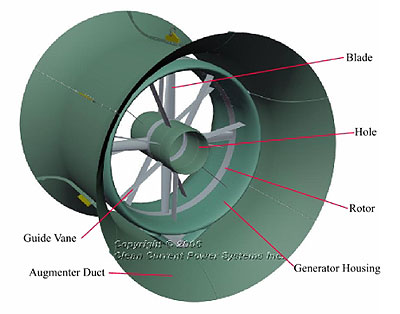 Clean Current's Bi-dierctional Open Turbine
Clean Current's Bi-dierctional Open TurbineExisting output is negligible, but if federal or state governments adopt policies and financial incentives to stimulate wave energy generation, capacity in the U.S. could reach 120 MW 3 in the near term.
Although the number of projects in the pipeline is growing dramatically, all are still at least five years from being commercially viable. Our review shows that in the past two years, the U.S. Federal Energy Regulatory Commission (FERC) has received over 15 new applications and issued over 30 preliminary permits. The situation is not unique to the U.S. Worldwide, there are only a few prototypes of the scale applicable for commercial generation.
Suitable Locations are Limited
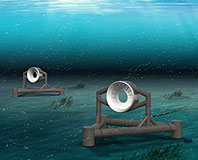 Open Hydro's Sea Bed Mounted Turbines
Open Hydro's Sea Bed Mounted TurbinesWave power is limited to locations between 40 and 60 degrees latitude where strong winds help generate large tides. Oregon, California, and Hawaii have the greatest potential for wave energy power generation. Although Alaska has sufficiently strong waves, the population is sparse. Likewise, Washington has strong waves but has limited capacity to transmit electricity from the coast to the inland load centers. 4 Potential also exists along the New England and Mid-Atlantic coastlines. 5
Tidal power has broader application, but developers need large channels and fast currents for utility-scale, MW-sized tidal power generating units. The few suitable channels in the U.S. are in remote northwestern islands. The market for smaller, 5 to 20 KW turbines offers the best potential.
Barriers to Development
-
Cost
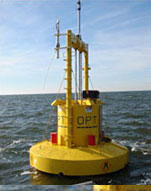 Ocean Power Technologies' Power Buoy
Ocean Power Technologies' Power Buoy
The projected energy costs are currently about twice as high as wind electrical generation and significantly higher than the national average electrical generation cost. Initial infrastructure costs for wave and tidal systems are also high. Costs are expected to significantly decrease as developers take advantage of learning through production and economies of scale. - Government Policy
Lack of U.S. government support and subsidies are consistently cited as some of the largest obstacles to commercial viability. Funding for research on wave and tidal power programs has been negligible until recently. Unlike all other renewable energy sources, wave and tidal energy projects are not eligible for renewable production tax credits. - Technology
Although technical issues are challenging, they are not insurmountable. Scientists understand the oceanography but still need to map and classify areas with suitable waves and tides. A wide variety of designs are being pursued, and wave energy devices have yet to close in on a single best approach for long-term operation in harsh marine conditions. Expertise is still emerging on how best to connect to the grid and marry technical expertise with commercial acumen. - Regulatory Approvals
The permitting process can be lengthy (lasting up to five years) and complex, requiring up to 25 federal, state, and local approvals. Government jurisdiction over systems installed between three and 12 miles offshore is not clear. In 2007, the FERC adopted a streamlined, preliminary permit process; this opened the door for developers to pilot test prototypes before obtaining the full cadre of permits required to generate energy for commercial use.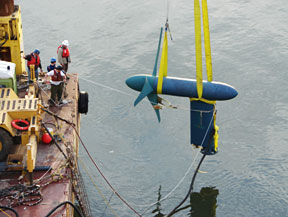 Verdant Power's turbine Installation at Roosevelt Island, New York
Verdant Power's turbine Installation at Roosevelt Island, New York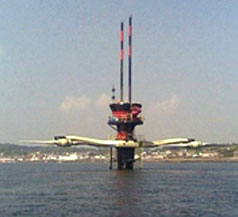 Marine Current Turbine's Sea Gen Turbine
Marine Current Turbine's Sea Gen Turbine - Environmental Impacts
Wave and tidal power's environmental impacts are probably low but mostly unknown. Stakeholders' concerns center on disruptions to fish or marine mammal migration, marine life becoming tangled in cables, and electrical cable systems interfering with commercial fishing and communication cable systems.
Incentives
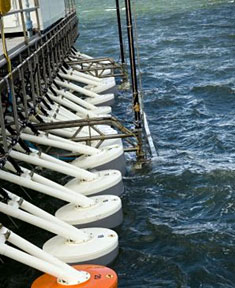 Wave Star Energy's Multi-point Absorber
Wave Star Energy's Multi-point AbsorberFinancial incentives are limited. Wave and tidal power systems are not yet eligible for renewable electricity production tax credits (PTC), investment tax credits, or five-year accelerated depreciation, all of which are available for other forms of renewable energy. 6
At the federal level, the Energy Policy Act provides general incentives for federal facilities to purchase renewable energy, but nothing specific for wave and tidal energy. The Act also authorized $250 million for ocean energy research and established a National Marine Renewable Research, Development, and Demonstration Center. Tidal and wave energy systems are eligible for Renewable Energy Production Incentives, which offer 1.5 cents per kWh produced to not-for-profit organizations that develop renewable energy systems.
At the state level, Renewable Portfolio Standards in 28 states require a specified percentage of energy sales or installed capacity to come from renewable sources, 7 but there are no specific incentives for wave and tidal energy.
Project Developers and Technology
As yet, there are no clear design or technology leaders, and no system has established a long term operating record at a commercial scale. Sean O'Neill, President of Ocean Renewable Energy Coalition, the U.S. trade association for wave and tidal technology, notes that "Projects are poised and big things are going to happen. The Department of Energy is committing $7.5 million to project developers in fiscal year 2008, with about a dozen bids being submitted for test systems." Some projects and developers with prototype systems in North America are highlighted below.
Tidal
In the United States, Verdant Power's Roosevelt Island Tidal Energy Project is the most promising to date; its six, 34 KW turbines delivered 50 MWh of electricity to New York City's grid during Phase 2 testing. Phase 3 of this demonstration project is underway.
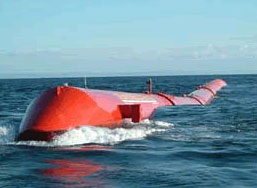 Pelamis Wave Energy Converter
Pelamis Wave Energy ConverterThere are currently no other projects in the United States capable of delivering energy to the grid. Ocean Renewable Power Company successfully completed its demonstration project in Eastport, Maine in April 2008 and final testing of the prototype unit will be completed in summer 2009. Companies developing prototype tidal technologies are listed in the following table.
| Developer | Locations |
|---|---|
| Verdant Power | New York (Roosevelt Island RITE project New York City) Ontario (Cornwall CORE project) |
| Marine Current Turbines | British Columbia (Vancouver) Nova Scotia (Bay of Fundy) |
| Open Hydro | Nova Scotia (Bay of Fundy) |
| Ocean Renewable Power | Maine (Eastport), Alaska, Florida |
| Clean Current | Nova Scotia (Bay of Fundy) |
Wave
Ocean currents present greater engineering challenges and harsher environments, and as a consequence, wave energy technology is less mature. Presently, there are no units with demonstrated power generating capacity in the United States.
Some of the more promising technologies and developers for wave energy systems include:
| Technology | Developer |
|---|---|
| Single point absorbers | Ocean Power Technologies' Power Buoy |
| Multiple point absorbers | Wavestar Energy |
| Floating attenuator devices | Pelamis Wave Power |
| Overtopping devices | Wave Dragon |
| Oscillating water columns | Wavegen's LIMPET |
Ocean Power Technologies is currently working on prototype projects in Hawaii and New Jersey. In 2007, Finnavera completed two months of preliminary testing of its Aqua Buoy (proposed for use in Washington and Oregon), but the unit was lost at sea after its pump system failed.
Footnotes
-
 Bedard, Roger.
Power and Energy Form the Ocean Energy Waves and Tides (Electric Power Research Institute, 2007).
Bedard, Roger.
Power and Energy Form the Ocean Energy Waves and Tides (Electric Power Research Institute, 2007). -
 Bedard, Roger et. al.
North American Ocean Energy Status (March 2007).
Bedard, Roger et. al.
North American Ocean Energy Status (March 2007). -
 Bedard, Roger.
Power and Energy Form the Ocean Energy Waves and Tides (Electric Power Research Institute, 2007).
Bedard, Roger.
Power and Energy Form the Ocean Energy Waves and Tides (Electric Power Research Institute, 2007). -
 Bedard, Roger et. al.
Ocean Waves Energy Conversion Technology (White Paper Submitted to the Western Governors Association Clean and Diversified Energy Advisory Committee, 2005).
Bedard, Roger et. al.
Ocean Waves Energy Conversion Technology (White Paper Submitted to the Western Governors Association Clean and Diversified Energy Advisory Committee, 2005). -
 Bedard, Roger et. al.
North American Ocean Energy Status (March 2007).
Bedard, Roger et. al.
North American Ocean Energy Status (March 2007). -
 Vining, J.G.
Economic Factors and Incentives for Ocean Wave Energy Conversion.
Vining, J.G.
Economic Factors and Incentives for Ocean Wave Energy Conversion. -
 Renewable Energy Portfolio Standards (Federal Electrical Regulatory Commission).
Renewable Energy Portfolio Standards (Federal Electrical Regulatory Commission).
